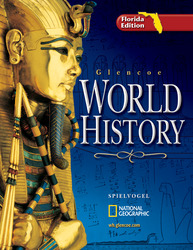Glencoe World History, Florida EditionChapter 6:
The World of Islam, 600–1500Web Activity Lesson PlansIntroduction
The hajj is one of the Five Pillars of Islam. It is not one ritual, but a defined set of pilgrimage rituals that are observed at a set time each year in and around Makkah. Each able-bodied Muslim is expected to participate in the hajj at least once in his or her life. Students will explore the hajj in detail and can gain a greater appreciation for how the hajj reinforces values and stories that are central to Islam. Lesson Description
Students will go to the Hajj Intro for People of Other Faith Web site to read about the development of the hajj, the rituals it comprises, and its symbolic value for Muslims. Students will answer four questions about what they have read. They will then compose a diary entry from the perspective of a Muslim participant in the hajj during the ninth century reign of Harun al-Rashid. The activity is an opportunity for students to visualize the hajj in detail, but also to imagine what life was like during the golden age of the Abbasid caliphate. Instructional Objectives - Students will be able to summarize the symbols, stories, and rituals around the hajj, one of the Five Pillars of Islam.
- Students will be able to apply their knowledge of the hajj rituals and of a specific period of Islamic civilization to describe a hajj during that time.
Student Web Activity Answers - According to the Quran, Makkah was the site where Hajar found water for herself and her young son Ishmail. When Ishmail was about thirteen years old, Abraham and Ishmail built the Kaaba (Kahbah) there.
- The hajj commemorates the trials of Abraham and his family in Makkah, including Abraham's willingness to sacrifice his son in response to God's command.
- A tawaf is a counter- clockwise procession around the Kaaba performed as one of the hajj rituals.
- During the hajj, Muslims remove their worldly clothing and don the simple, white attire of pilgrims. This symbolizes a state of human equality and unity before God.
- Students' diary entries should contain detail about the prosperity of Islamic civilization during this period. The entries should reflect the diversity of pilgrims in Makkah and an understanding of the hajj rituals and their meanings.
 | 






